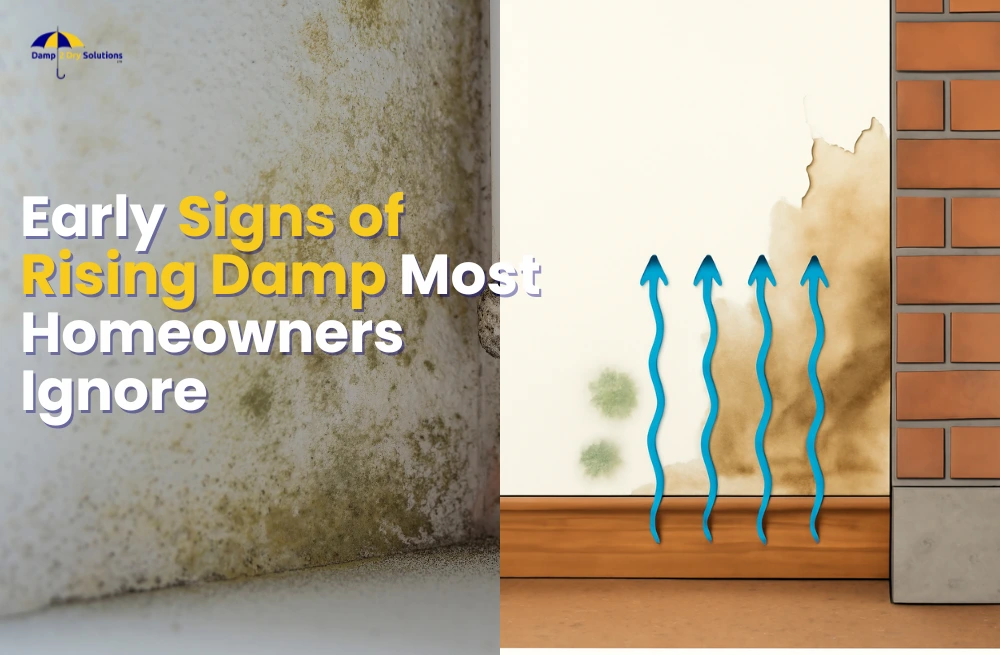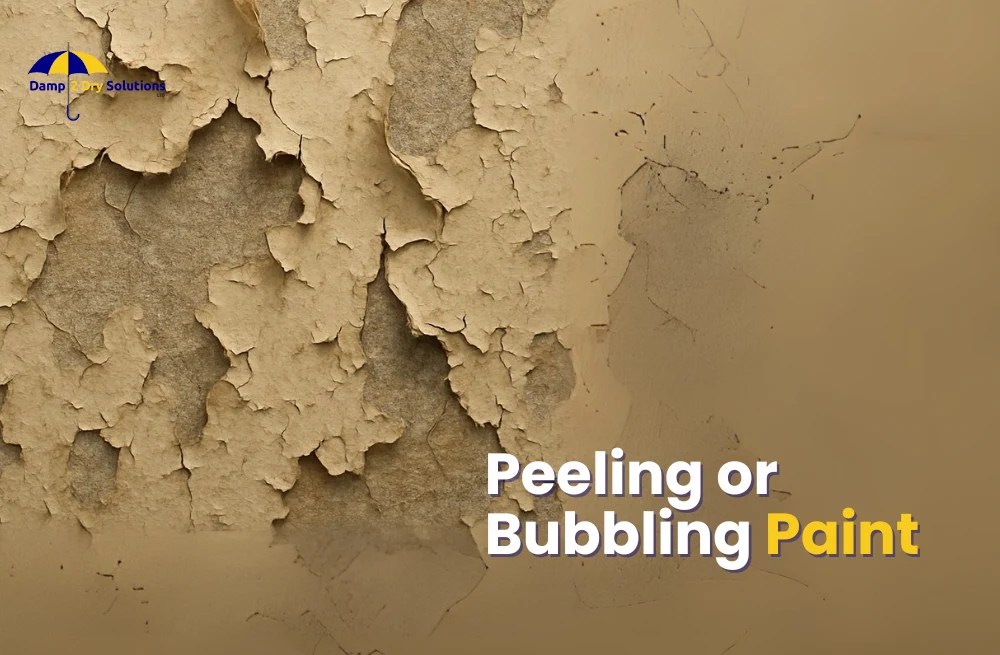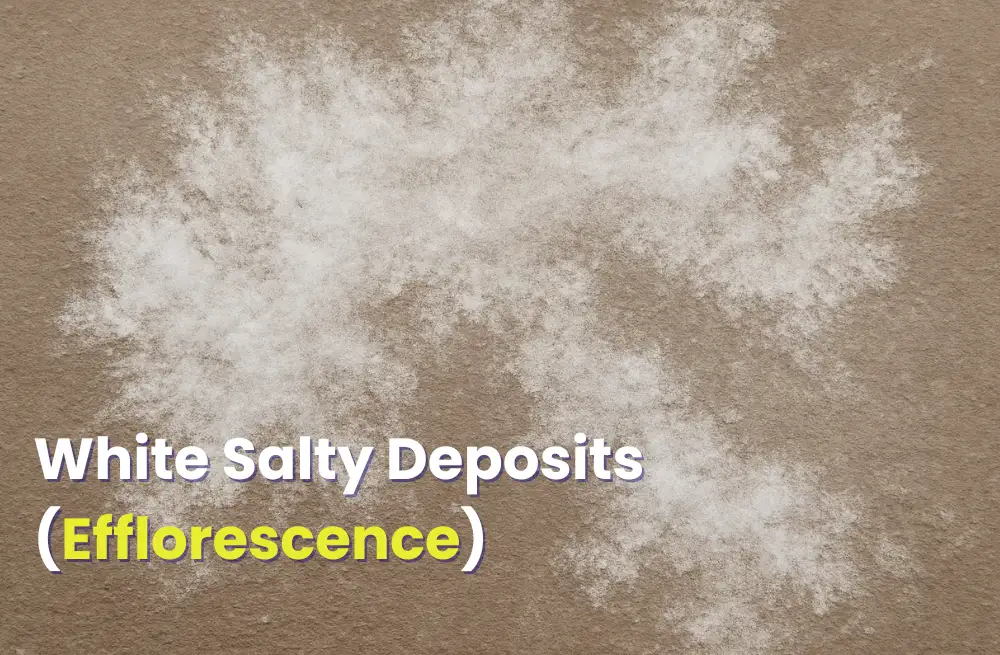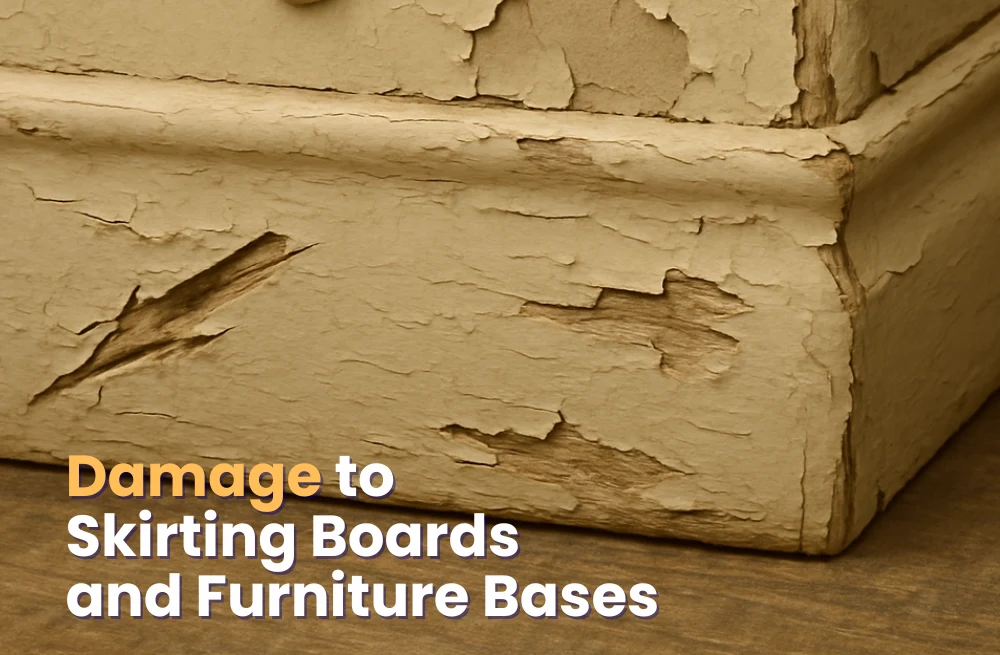
Rising damp. It’s one of those hidden household issues that sneaks up on you, silently damaging your walls, flooring, and even your health. Most homeowners in the UK brush off the early signs, chalking them up to “just a bit of condensation” or a draft. But that little patch on the wall or faint musty smell could cost you thousands down the line.
Let’s be real: Nearly 1 in 5 UK homes suffer from damp-related problems, and rising damp is one of the main culprits. If left untreated, it can ruin your plaster, rot your timber floors, cause mould growth, and even knock value off your property. But here’s the good news, it gives off clear warning signs. The trick is knowing what to look for.
So, here are seven early signs of rising damp that most homeowners ignore (but really shouldn’t).
1. Peeling or Bubbling Paint

Ever noticed your wall paint starting to blister, peel or bubble, especially near the bottom of walls? That’s not just bad decorating or poor-quality paint. It’s often one of the first signs of rising damp creeping in.
When moisture travels upwards from the ground through porous bricks and mortar, it gets trapped behind layers of paint. Eventually, the pressure builds up and causes the paint to lift and flake. Unlike condensation, which tends to affect ceilings and windows, rising damp usually attacks the lower parts of your wall.
Tip: Check areas around skirting boards, chimney breasts, and the bottom corners of rooms. These are the spots where bubbling paint tends to appear first.
Also read: Does Anti Mould Paint Really Work?
2. Musty Smell That Won’t Go Away
You know that damp, earthy smell that lingers no matter how many candles or air fresheners you use? That’s your home trying to tell you something.
Rising damp brings moisture into places it shouldn’t be, and where there’s moisture, there’s usually mould, bacteria, and decaying organic matter. The result? A stale smell that clings to your carpets, furniture, and soft furnishings.
This smell is most common in basements, hallways, and ground-floor rooms, especially those without much sunlight or airflow. Unlike cooking or pet odours, this one never really clears.
Note: Air fresheners may mask it temporarily, but they won’t solve the root problem. If your home smells like wet soil or rotting wood, rising damp could be the cause.
3. Dark Patches on Internal Walls
You might spot what looks like a faint shadow on your wall, or maybe a brownish discolouration. These aren’t just aesthetic issues, they’re red flags.
Dark patches caused by rising damp typically appear in a tide mark formation, up to about 1 metre high from the ground. This is a classic sign that groundwater is being drawn up into your walls.
Unlike a leaky pipe or heavy rainfall from outside, rising damp affects internal walls in consistent patterns and doesn’t usually spread upwards. The patches may be soft to the touch, slightly cooler, or simply look like the paint has dulled in areas.
Add: If it looks like a shadow that doesn’t go away, it’s time to investigate further.
4. Crumbling Plaster or Wall Materials
Touch your wall and it feels hollow, flaky, or powdery? That’s not normal. When rising damp attacks plaster, it slowly breaks down the material from inside, leaving it weak and crumbly.
You might notice bits of plaster coming off with the lightest tap or sections of wall that sound different when knocked. Repainting over these areas won’t fix anything, the moisture will just rise again, and you’ll be back to square one in a few weeks.
Note: Don’t be fooled into thinking a quick skim and paint job will sort it. Rising damp needs to be treated at the source.
5. White Salty Deposits (Efflorescence)

This one’s sneaky. Many people spot it and think it’s just dust or residue, so they wipe it off and forget about it. But that chalky white stuff on your wall? It’s called efflorescence, and it’s a tell-tale sign of rising damp.
Here’s what happens: moisture seeps up from the ground, carrying salts from the bricks or mortar. When the moisture evaporates at the surface, it leaves behind a white, powdery deposit.
Suggestion: Take a photo every time you see it return. If it keeps coming back in the same place, that’s a strong indicator of an underlying damp problem, not just surface condensation.
6. Cold or Damp Flooring
Have you walked across a carpet or wooden floor and noticed it felt unusually chilly or slightly damp underfoot? That’s not always due to poor insulation or draughty floorboards, sometimes it’s rising damp working its way up from the subfloor.
In older homes, especially those with suspended timber floors, damp can travel through air bricks and start affecting joists and boards. Over time, this leads to wood rot, mould, and warped flooring.
This issue is often mistaken for general coldness, especially in winter. But if only one room or corner feels affected, and it’s getting worse, it’s worth investigating.
Add: Don’t ignore cold or spongy patches under rugs or near exterior walls.
7. Damage to Skirting Boards and Furniture Bases

Here’s one that many homeowners don’t even notice until it’s too late. Rising damp doesn’t just stick to walls, it spreads into wooden skirting boards and furniture bases.
You might see:
- Paint flaking off the bottom of furniture legs
- Skirting boards pulling away from the wall
- Swollen wood or soft spots along the base
If the issue reaches this stage, it’s not just a cosmetic problem anymore. This could mean that moisture has been present for quite some time, and that your structural timber might be at risk.
Emphasise: If your table legs or kitchen units are starting to flake or swell near the floor, don’t write it off. Rising damp often travels higher than expected.
Signs of Rising Damp to Watch For (Based on Where It Shows Up)
Whether it’s your bedroom, external wall, or an older part of the house, rising damp leaves different clues depending on where it strikes. Use the table below to spot early warning signs in key areas of your home.
| Area Affected | Common Signs of Rising Damp | Things to Watch |
|---|---|---|
| Rising Damp in Walls | – Tide marks up to 1 metre high – Peeling or bubbling paint – Crumbling plaster – White salt deposits (efflorescence) |
Most visible on internal ground floor walls and behind furniture |
| Rising Damp Outside | – Green algae or moss near bottom of external walls – Eroding mortar – Salt stains or flaking brickwork |
Have a look near drains, garden paths, or where the damp-proof course may be bridged |
| Rising Damp in Bedroom | – Cold, damp air especially near external walls – Musty odour – Damage to skirting boards – Staining behind wardrobes or beds |
Often mistaken for condensation — check lower parts of the wall and behind furniture |
| Rising Damp in Ceiling | – Unlikely for true rising damp — more often a sign of roof leaks or plumbing issues | Rising damp doesn’t go above 1–1.2m; ceiling patches usually suggest other problems |
| Rising Damp in an Old House | – Flaking plaster – Damp floorboards – Tide marks – Rotten skirting boards – Persistent odour |
Older homes may have no damp-proof course or one that’s failed or been bridged |
What Happens If You Ignore It?
Let’s not sugar-coat it, ignoring rising damp can get expensive. What starts as a little patch or smell can turn into:
- Structural timber decay
- Health risks from mould spores and poor indoor air quality
- Decreased property value
- Costly repairs to plaster, brickwork, flooring and furniture
The longer you leave it, the deeper the damage goes. And once your timber starts rotting or your walls crumble, you’re not just dealing with damp, you’re dealing with a full-blown renovation.
Final Thoughts: Catch It Early, Save Big
Rising damp won’t knock on your door and introduce itself. But it does leave plenty of clues, bubbling paint, musty smells, salty marks, cold floors, and crumbling plaster, to name a few.
If you’ve spotted any of these signs in your home, especially on the ground floor or basement level, don’t wait for things to get worse. A simple survey could save you thousands in the long run.
And if you’re in Cheshire, Manchester, Liverpool, Stoke-on-Trent, Chester, Warrington, or Newcastle, the team at Damp 2 Dry Solutions are just around the corner. We offer independent damp surveys and professional rising damp treatments, no pressure, no sales pitch, just honest advice and expert fixes.
Don’t ignore the signs, book your inspection with Damp 2 Dry Solutions today.
